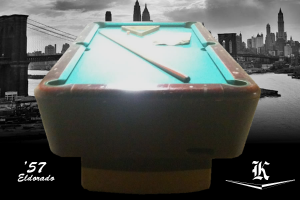Chances are if you own a pre-1970s Irving Kaye pool table its one of the Eldorado family models. In 1955 when Irving Kaye Co. Inc. was formed they started as a manufacturer making replacement slate tops and supplying pool tale accessories for other manufacturers’ tables. Since they were cutting and drilling slate in their own factory they even offered a 6-pocket retrofit conversion for other manufacturers’ bumper pool tables. (These retrofit kits included 15 small balls an oversized cue ball and new rails.) But midway through 1957, Irving Kaye got into the pool table business for real.
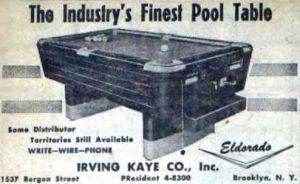 1957 was a time when the pool table manufacturing business was beginning a business boom. Within five years the big five American Shuffle Board Corp., Fischer Sales & Mfg. Co., Irving Kaye Co. Inc., U.S. Billiards Inc., and the Valley Sales Company were all producing bumper pool tables and the larger 6-pocket versions at breakneck speeds.
1957 was a time when the pool table manufacturing business was beginning a business boom. Within five years the big five American Shuffle Board Corp., Fischer Sales & Mfg. Co., Irving Kaye Co. Inc., U.S. Billiards Inc., and the Valley Sales Company were all producing bumper pool tables and the larger 6-pocket versions at breakneck speeds.
Irving Kaye saw this opportunity and with his silent business partner Gerardo Catena, he entered the fray with two bumper pool tables and then finally in July of 1957, the original Eldorado (76×44) was born. Named after the top of the line Cadillac and featuring a single piece of slate, a Mahogany painted plywood cabinet with Gold trim, modern Formica top rails, and recessed scoring panels, ball returns and coin mechanisms at the end of the table. With the introduction of the Eldorado Kaye set out to build the finest bar box pool tables in the industry. Irving Kaye Co. Inc. would ride this coin-op boom for the next 15 years.
In January 1957 Kaye moved production from Manhatten to Brooklyn into a 20,000 square foot facility. By July 1957 sales were very strong and Irving Kaye reported they were manufacturing 80 tables a week and they were ramping up to manufacture 100 a week by the end of the year. The original Eldorado tables were set up to play as 20c (two dimes) or 25c (one quarter).
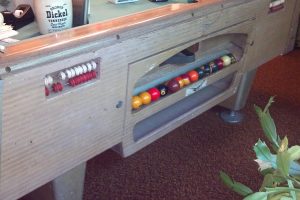
By 1960 the coin and ball returns had been moved to a flush drawer on the side of the table with full ball viewer above. The 1960 models have recessed scoring panels and exposed rail screws on the sides.
 By 1960 Kaye had moved again into an even larger 30,000 sq ft building at 363 Prospect Place in Brooklyn and the Eldorado was significantly redesigned and offered in three sizes as Mark I (77×45), Mark II (82×46) and Mark III (92×52). The redesign was significant moving the ball return and coin mechanism to the side of the table a “flush” design that would eliminate damage to the tables and injury to the players. In addition, Kaye included a full ball viewer to allow players to view played balls from any angle. Other features included no-bolt legs, steel corners on the pockets and the entire coin and ball mechanism was housed in a removable drawer. In ’61 the even larger Mark IV (106×58) was introduced.
By 1960 Kaye had moved again into an even larger 30,000 sq ft building at 363 Prospect Place in Brooklyn and the Eldorado was significantly redesigned and offered in three sizes as Mark I (77×45), Mark II (82×46) and Mark III (92×52). The redesign was significant moving the ball return and coin mechanism to the side of the table a “flush” design that would eliminate damage to the tables and injury to the players. In addition, Kaye included a full ball viewer to allow players to view played balls from any angle. Other features included no-bolt legs, steel corners on the pockets and the entire coin and ball mechanism was housed in a removable drawer. In ’61 the even larger Mark IV (106×58) was introduced.
In 1963 the Eldorado line got another significant redesign. Kaye smoothed out the sides removing the scoring panels and replaced them with cast pieces with “digital” counters recessed into the top rail. The exposed rail screws were also gone hidden with extruded aluminum channels with rubber inserts. Also for 63, Kaye introduced the regulation size Mark V (113×63) with a 3-piece slate playing surface.

The new ’63 design eliminated the side counters and exposed side screws and added molded rubber pocket boots and a new tapered leg design.
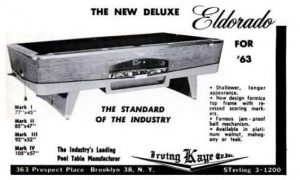
 In the summer of ’63 the Eldorado was treated to a two-tone paint scheme which added significant visual appeal to the table making it look shallower and longer. The two-tone finishes were Platinum Walnut with a silver base, Mahogany with a brown base and Teak with a cream base. These color schemes were designed to complement the wood-grain Formica used on the top rails.
In the summer of ’63 the Eldorado was treated to a two-tone paint scheme which added significant visual appeal to the table making it look shallower and longer. The two-tone finishes were Platinum Walnut with a silver base, Mahogany with a brown base and Teak with a cream base. These color schemes were designed to complement the wood-grain Formica used on the top rails.
Then in 1964, the Eldorado received another design enhancement. Kaye removed the ball return from below the ball viewer and moved it to the rack end of the table. With the cue returning to the shooter’s end this enhancement not only made the cabinet cleaner but also sped up the pace of play. For 64 the Mark I, II & III cabinets could be ordered in all-Formica or in the two-tone painted finish. The Mark IV and Mark V (114×64) were only sold finished in all-Formica. Color options were simplified to Platinum walnut with a creme base and Mahogany with brown base.
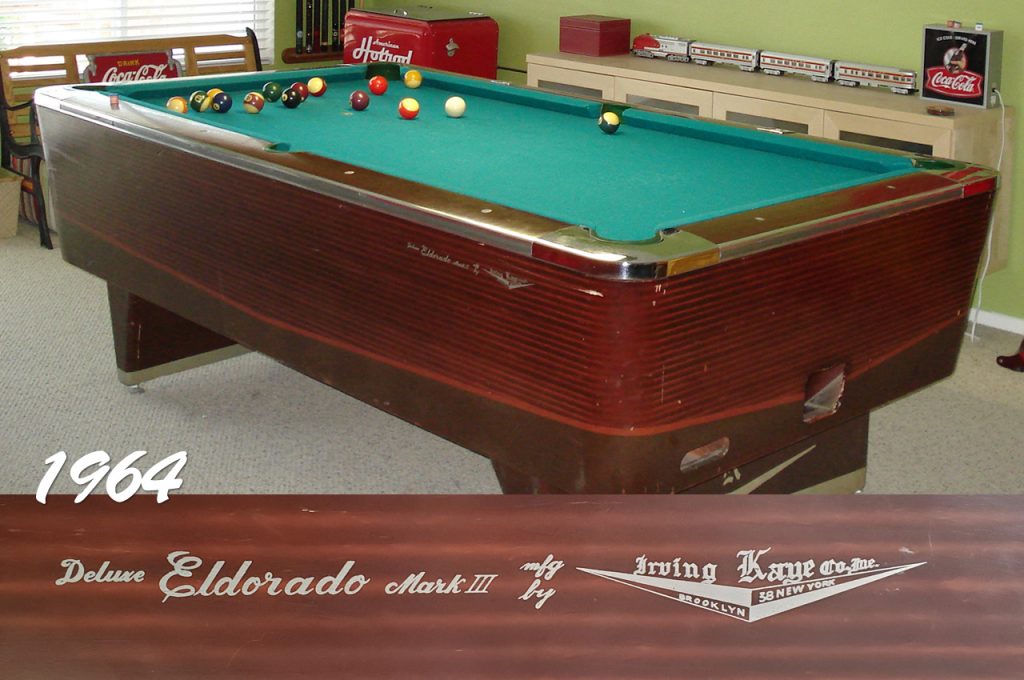
Irving Kaye Deluxe Eldorado Mark III built-in 1964. Mahogany with a red accent stripe, brown base, and silver trim, chevron and K on the legs.

 The final installment of the Eldorado line was the radically redesigned Eldorado ’66. This table was touted by Kaye as the “Operators Dream Come True”. In this design, the body was streamlined and coming full-circle, Kaye moved the coin mechanism, ball viewer and ball return tray back to the rack end of the table.
The final installment of the Eldorado line was the radically redesigned Eldorado ’66. This table was touted by Kaye as the “Operators Dream Come True”. In this design, the body was streamlined and coming full-circle, Kaye moved the coin mechanism, ball viewer and ball return tray back to the rack end of the table.
Also significantly, the inside of the table was completely redesigned. The entire ball runway was simplified and was removable eliminating the need to remove the slate to clean or service the inside of the table. Also added for ’66 was the Junior IV (101×58). The ’66 was available in a unique Platinum Walnut paint-only finish or all Formica in Ebony or Teak and also featured new swing away legs. Download the ![]() Deluxe Eldorado 2-page Factory Brochure
Deluxe Eldorado 2-page Factory Brochure
The Deluxe Eldorado 66 was the last of the line of the Irving Kaye Eldorado pool tables. These tables epitomized mid-century design with their “big fin” inspired name and table designs that helped Irving Kaye Co. Inc. to become one of the big 5 pool table manufacturers. But like everything else, change was coming and with the ’70s on the horizon and the space race in full swing, the Eldorados would give way to the new Irving Kaye Apollo’s that would start coming off the factory line in 1969.
